MGF-Based Mutual Approximation of Hybrid Fading: Performance of Wireless/Power Line Relaying Communication for IoT
Abstract
:1. Introduction
- (1)
- System performance is analyzed based on the mutual approximation of different channel fading. Considering the similarity between LogN and Gamma distributions, we propose an s vectors joint optimization algorithm based on moment generating function (MGF) equations and the principle of minimum difference between PDFs to determine the key parameters of approximate fading PDF and achieve high approximate accuracy.
- (2)
- After the LogN distribution is approximated to the Gamma distribution (L2G), we derive the MGF of the harmonic mean of two Gamma distribution variables with the Appell function F1 form and use the MGF to obtain the BER, outage probability, and diversity order of the system. Compared with other studies, the MGF derived in this study must only calculate the Appell hypergeometric function once. This function has high accuracy, low complexity, and is suitable for any Nakagami-m fading parameter value.
- (3)
- This study proposes an algorithm similar to (1) for determining the optimal distribution parameters and optimal s values based on the approximation of the LogN variable sum. The Gamma distribution is approximated to the LogN distribution (G2L) based on the principle of minimizing the MGF difference. In addition, the Gauss-Hermite series, integral changes, Mehta, and other algorithms are comprehensively applied to analyze the performance indicators of the double LogN distribution system.
- (4)
- The versatility and accuracy of the two approximation algorithms are verified by using the Monte Carlo simulation, and the difference of the L2G and G2L algorithms is compared and analyzed in the calculated system performance for effectiveness and reliability. At the same time, the influence of the hybrid channel fading and multidimensional impulse noise on the system performance is analyzed. The simulation results show that both approximation algorithms have high accuracy, but the L2G algorithm can analyze system performance more accurately, and the G2L algorithm can be used to analyze other performances besides BER and outage since the PDF of terminal signal to noise ratio (SNR) is known.
2. System Description
2.1. First Time Slot
2.2. Second Time Slot
3. Performance Analysis
3.1. Mutual Approximation Algorithm Based on the PDF and MGF Equations
- (1)
- ;
- (2)
- ;
- (3)
- Hi = 0.01 + 0.05 × (i 1);
- (4)
- i = 1,2, …, N;
- (5)
- s1 > 0;
- (6)
- s2 > 0;
- (1)
- (The choice of s value that will affect the prediction of the PDF curve coincidence is verified.
- (2)
- Although the MGF equation approximation lacks analytical expressions, it can be optimized through s1 and s2 with increased accuracy.
3.2. Performance Analysis of MGF Based on Harmonic Mean of the Double Gamma Distribution System
3.3. Performance Analysis of the Double LogN Distribution System Based on the Approximation of the LogN Variable Sum
4. Numerical Results and Discussion
5. Conclusions
Author Contributions
Funding
Conflicts of Interest
Appendix A
References
- Dubey, A.; Mallik, R.K. PLC system performance with AF relaying. IEEE Trans. Commun. 2015, 63, 2337–2345. [Google Scholar] [CrossRef]
- Ferreira, H.C.; Lampe, L.; Newbury, J.; Swart, T.G. Power Line Communications: Theory and Applications for Narrowband and Broadband Communications over Power Lines; Wiley: Hoboken, NJ, USA, 2011. [Google Scholar]
- Guzelgoz, S.; Celebi, H.B.; Arslan, H. Statistical characterization of the paths in multipath PLC channels. IEEE Trans. Power Deliv. 2011, 26, 181–187. [Google Scholar] [CrossRef]
- Cho, W.; Cao, R.; Yang, L. Optimum resource allocation for amplify-and-forward relay networks with differential modulation. IEEE Trans. Signal Process. 2008, 56, 5680–5691. [Google Scholar]
- Papaleonidopoulos, I.C.; Capsalis, C.N.; Karagiannopoulos, C.G.; Theodorou, N.J. Statistical analysis and simulation of indoor singlephase low voltage power-line communication channels on the basis of multipath propagation. IEEE Trans. Consum. Electron. 2003, 49, 89–99. [Google Scholar] [CrossRef]
- Hong, Y.W.P.; Jen, H.W.; Kuo, C.C.J. Cooperative Communications and Networking: Technologies and System Design; Springer: New York, NY, USA, 2010. [Google Scholar]
- Zou, H.; Chowdhery, A.; Jagannathan, S.; Cioffi, J.M.; Masson, J.L. Multi-user joint subchannel and power resource-allocation for power line relay networks. In Proceedings of the 2009 IEEE International Conference on Communications, Dresden, Germany, 14–18 June 2009; pp. 1–5. [Google Scholar]
- Tan, B.; Thompson, J. Relay transmission protocols for in-door power line communications networks. In Proceedings of the 2011 IEEE International Conference on Communications Workshops (ICC), Kyoto, Japan, 5–9 June 2011; pp. 1–5. [Google Scholar]
- Balakirsky, V.B.; Vinck, A.J.H. Potential performance of PLC systems composed of several communication links. In Proceedings of the International Symposium on Power Line Communications and Its Applications, Vancouver, BC, Canada, 6–8 April 2005; pp. 12–16. [Google Scholar]
- Lampe, L.; Schober, R.; Yiu, S. Distributed space-time coding for multihop transmission in power line communication networks. IEEE J. Sel. Areas Commun. 2006, 24, 1389–1400. [Google Scholar] [CrossRef]
- Dubey, A.; Mallik, R.K.; Schober, R. Performance analysis of a multihop power line communication system over log-normal fading in presence of impulsive noise. IET Commun. 2015, 9, 1–9. [Google Scholar] [CrossRef]
- Lampe, L.; Vinck, A.J.H. On cooperative coding for narrow band PLC networks. AEU Int. J. Electron. Commun. 2011, 65, 681–687. [Google Scholar] [CrossRef]
- Rabie, K.M.; Adebisi, B.; Tonello, A.M.; Nauryzbayev, G. For more energy-efficient dual-hop DF relaying power-line communication systems. IEEE Syst. J. 2018, 12, 2005–2016. [Google Scholar] [CrossRef]
- Lai, S.W.; Messier, G.G. The wireless/power-line diversity channel. In Proceedings of the 2010 IEEE International Conference on Communications, Cape Town, South Africa, 23–27 May 2010. [Google Scholar]
- Chen, Z.; Han, D.; Qiu, L. Research on performance of indoor wireless and power line dual media cooperative communication system. Proc. CSEE 2017, 37, 2589–2598. [Google Scholar]
- Mathur, A.; Bhatnagar, M.R.; Panigrahi, B.K. Performance of a dual-hop wireless-powerline mixed cooperative system. In Proceedings of the 2016 International Conference on Advanced Technologies for Communications (ATC), Hanoi, Vietnam, 12–14 October 2016. [Google Scholar]
- Lai, S.W.; Messier, G.G. Using the wireless and PLC channels for diversity. IEEE Trans. Commun. 2012, 60, 3865–3875. [Google Scholar] [CrossRef]
- Sarafi, A.M.; Tsiropoulos, G.I.; Cottis, P.G. Hybrid wireless broadband over power lines: A promising broadband solution in rural areas. IEEE Commun. Mag. 2009, 47, 140–147. [Google Scholar] [CrossRef]
- Zimmermann, M.; Dostert, K. Analysis and modeling of impulsive noise in broad-band power line communications. IEEE Trans. Electromagn. Compat. 2002, 44, 249–258. [Google Scholar] [CrossRef]
- Herath, S.P.; Tran, N.H.; Lengoc, T. Optimal signaling scheme and capacity limit of PLC under Bernoulli-Gaussian impulsive noise. IEEE Trans. Power Deliv. 2015, 30, 97–105. [Google Scholar] [CrossRef]
- Mehta, N.B.; Wu, J.; Molisch, A.F.; Zhang, J. Approximating a sum of random variables with a lognormal. IEEE Trans. Wirel. Commun. 2007, 6, 2690–2699. [Google Scholar] [CrossRef]
- Chen, Z.; Jing, Y.; Han, D. Power optimization allocation based on approximation of moment generator function in dual media cooperative communication. Autom. Electr. Power Syst. 2018, 42, 159–167. [Google Scholar] [CrossRef]
- Chu, S.I. Performance of amplify-and-forward cooperative communications with the N^{th} best-relay selection scheme over Nakagami-m fading channels. IEEE Commun. Lett. 2011, 15, 172–174. [Google Scholar] [CrossRef]
- Yang, J.; Fan, P.; Duong, T.Q.; Lei, X. Exact performance of two-way AF relaying in Nakagami-m fading environment. IEEE Trans. Wirel. Commun. 2011, 10, 980–987. [Google Scholar] [CrossRef]
- Ikki, S.S.; Ahmed, M.H. Performance of cooperative diversity using Equal Gain Combining (EGC) over Nakagami-m fading channels. IEEE Trans. Wirel. Commun. 2009, 8, 557–562. [Google Scholar] [CrossRef]
- Xia, M.; Aissa, S. Moments based framework for performance analysis of one-way/two-way CSI-assisted AF relaying. IEEE J. Sel. Areas Commun. 2012, 30, 1464–1476. [Google Scholar] [CrossRef]
- Li, J.; Qian, X.; Ge, J.; Zhang, C. General and efficient relay selection for two-way opportunistic amplify-and-forward relaying. Electron. Lett. 2014, 50, 1886–1888. [Google Scholar] [CrossRef]
- Guzelgoz, S.; Celebi, H.B.; Arsian, H. Analysis of a multi-channel receiver: Wireless and PLC reception. In Proceedings of the European Signal Processing Conference, Aalborg, Denmark, 23–27 August 2010. [Google Scholar]
- Hasna, M.O.; Alouini, M.S. Harmonic mean and end-to-end performance of transmission systems with relays. IEEE Trans. Commun. 2004, 52, 130–135. [Google Scholar] [CrossRef]
- Gradshteyn, I.S.; Ryzhik, I.M. Table of Integrals, Series, and Products, 7th ed.; Academic Press: Cambridge, MA, USA, 2007. [Google Scholar]
- Wang, Z.; Giannakis, G.B. A simple and general parameterization quantifying performance in fading channels. IEEE Trans. Commun. 2003, 51, 1389–1398. [Google Scholar] [CrossRef]
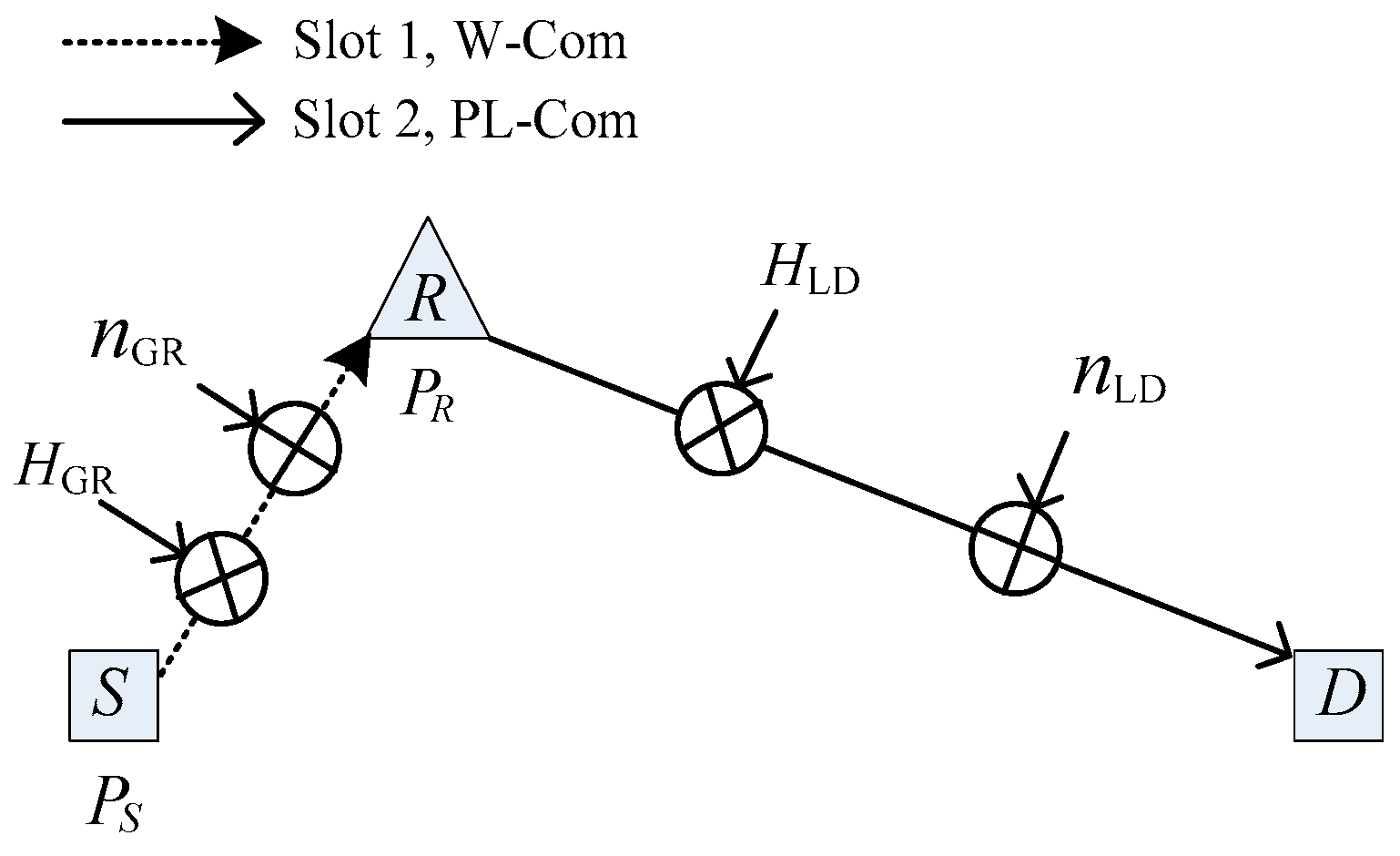



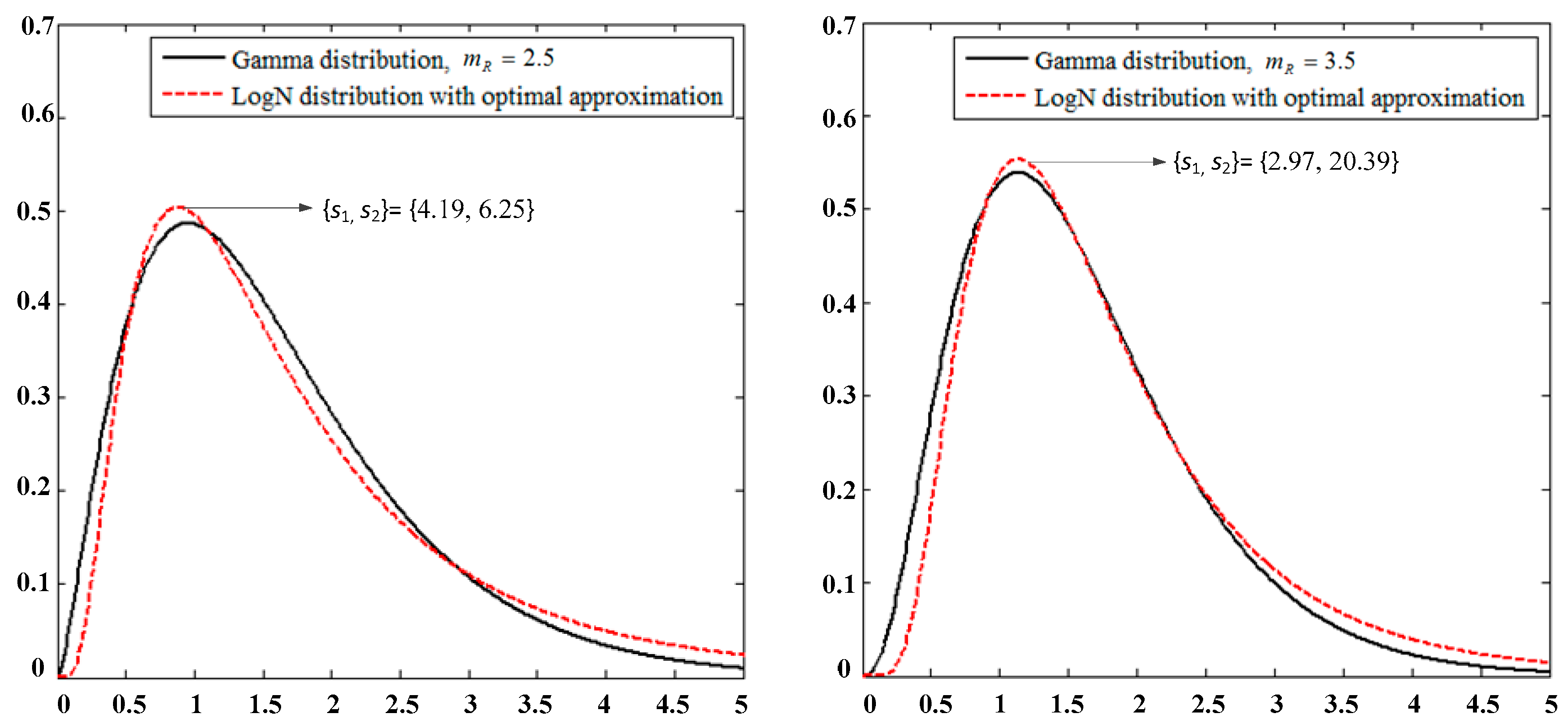
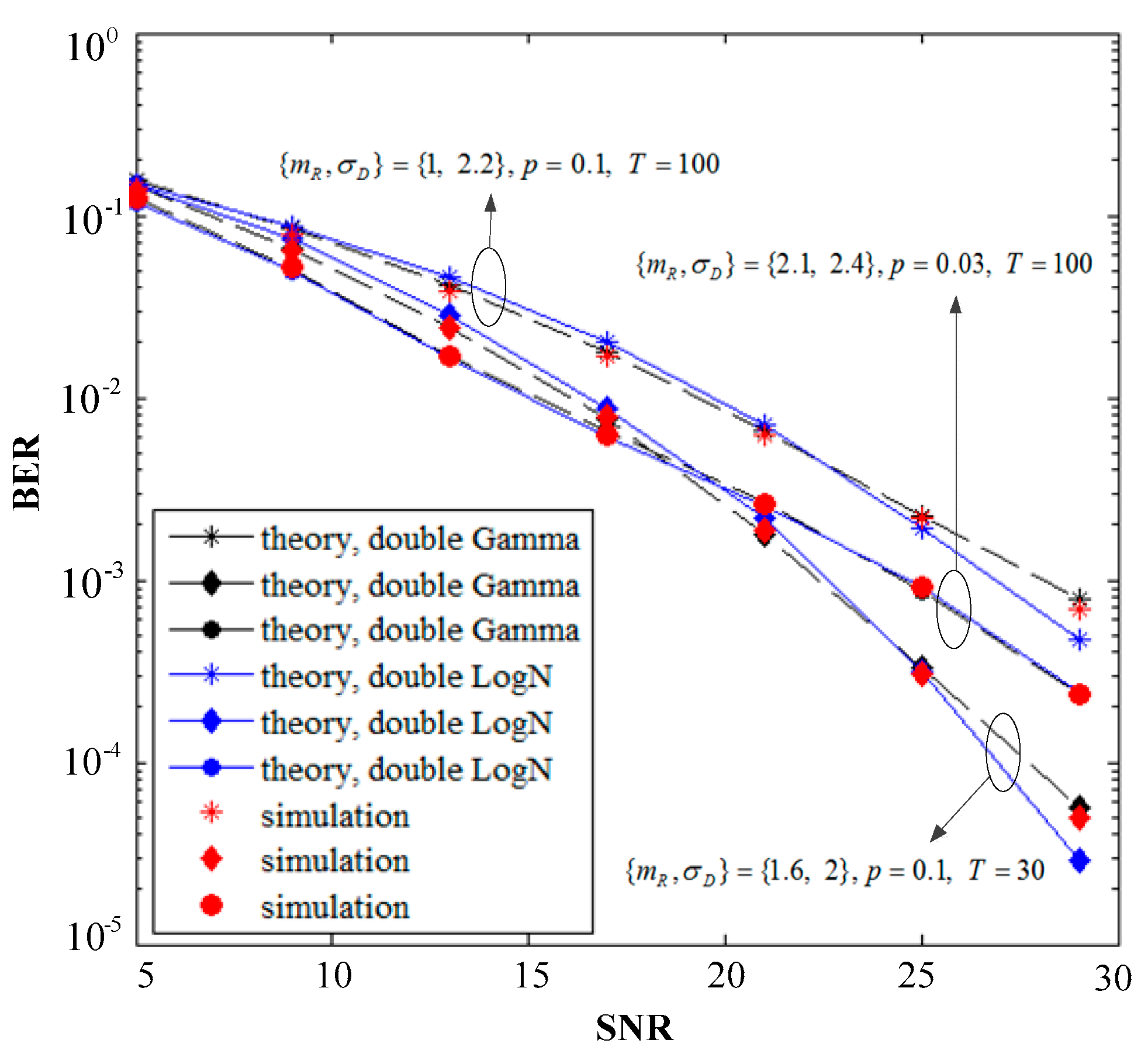
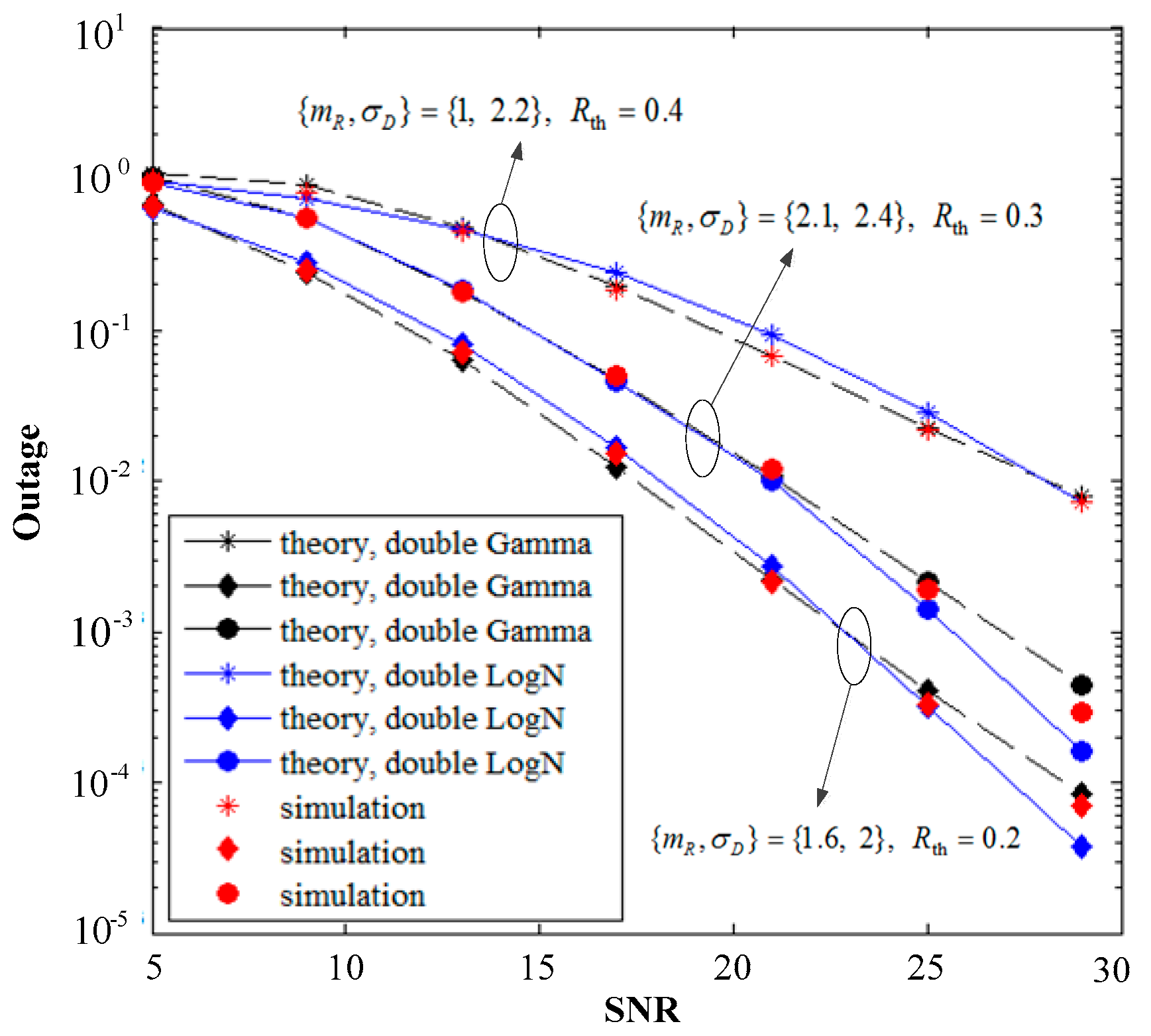

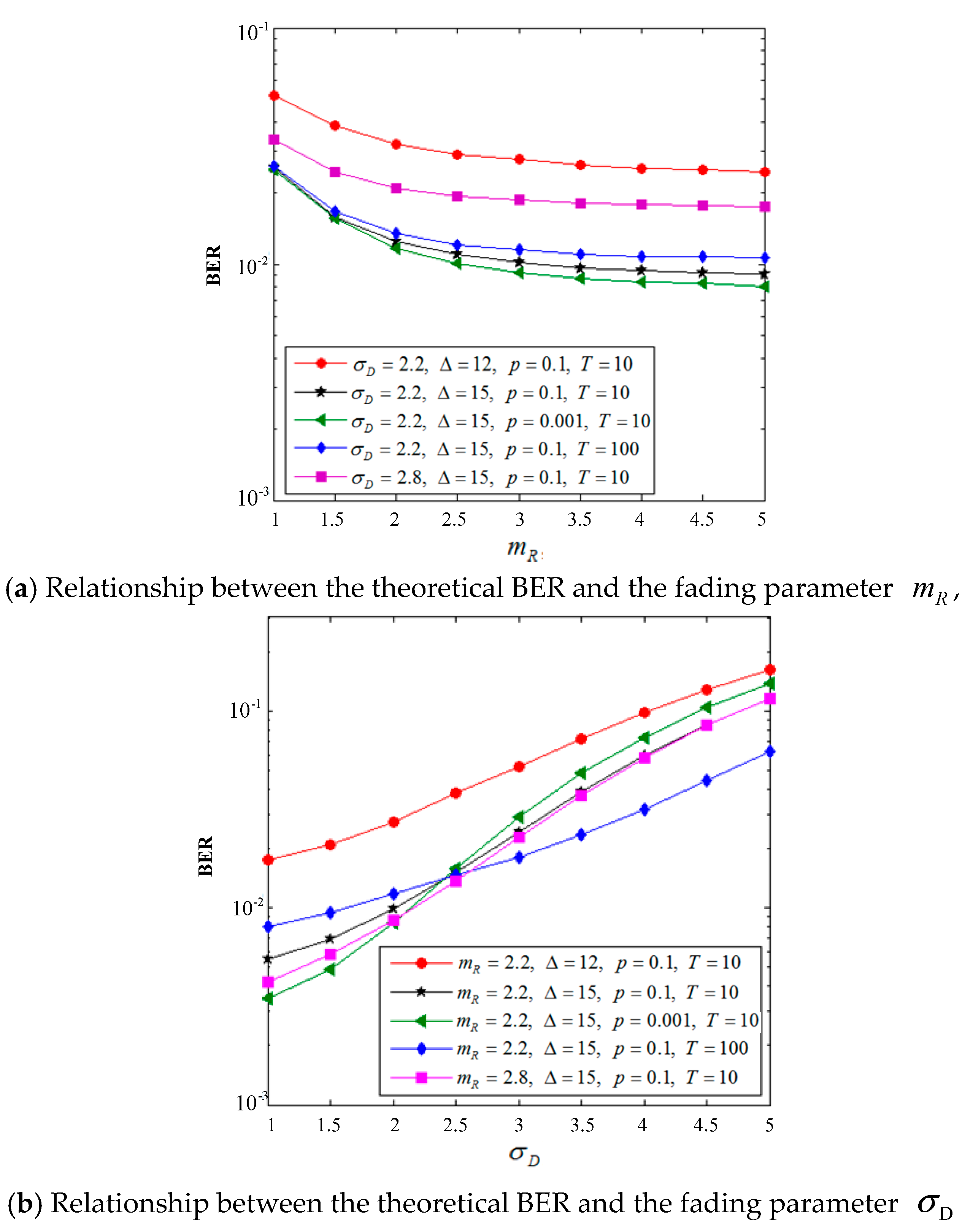
| σD | s1 | s2 | mD | D | Objective Function |
|---|---|---|---|---|---|
| 2 | 3.2051 | 23.6809 | 4.2187 | 0.1997 | 2.0254 |
| 2.5 | 2.8908 | 24.6753 | 3.4932 | 0.2339 | 1.0062 |
| 2.8 | 2.8617 | 22.8037 | 3.1355 | 0.2561 | 0.6931 |
| 3 | 3.0924 | 17.5526 | 2.8639 | 0.2776 | 0.6951 |
| 3.3 | 3.2179 | 15.1707 | 2.5934 | 0.3015 | 0.7413 |
| mR | s1 | s2 | Objective Function | ||
|---|---|---|---|---|---|
| 2 | 3.7589 | 14.7629 | −0.0852 | 0.4554 | 0.8255 |
| 2.5 | 4.1872 | 21.2461 | −0.0472 | 0.4197 | 0.6104 |
| 2.9 | 2.4379 | 15.7817 | −0.0416 | 0.4005 | 0.5272 |
| 3.2 | 2.3628 | 20.4712 | −0.0340 | 0.3854 | 0.5281 |
| 3.5 | 2.9697 | 20.3867 | −0.0178 | 0.3700 | 0.7707 |
© 2019 by the authors. Licensee MDPI, Basel, Switzerland. This article is an open access article distributed under the terms and conditions of the Creative Commons Attribution (CC BY) license (http://creativecommons.org/licenses/by/4.0/).
Share and Cite
Chen, Z.; Ye, C.; Yuan, J.; Han, D. MGF-Based Mutual Approximation of Hybrid Fading: Performance of Wireless/Power Line Relaying Communication for IoT. Sensors 2019, 19, 2460. https://doi.org/10.3390/s19112460
Chen Z, Ye C, Yuan J, Han D. MGF-Based Mutual Approximation of Hybrid Fading: Performance of Wireless/Power Line Relaying Communication for IoT. Sensors. 2019; 19(11):2460. https://doi.org/10.3390/s19112460
Chicago/Turabian StyleChen, Zhixiong, Cong Ye, Jinsha Yuan, and Dongsheng Han. 2019. "MGF-Based Mutual Approximation of Hybrid Fading: Performance of Wireless/Power Line Relaying Communication for IoT" Sensors 19, no. 11: 2460. https://doi.org/10.3390/s19112460
APA StyleChen, Z., Ye, C., Yuan, J., & Han, D. (2019). MGF-Based Mutual Approximation of Hybrid Fading: Performance of Wireless/Power Line Relaying Communication for IoT. Sensors, 19(11), 2460. https://doi.org/10.3390/s19112460





